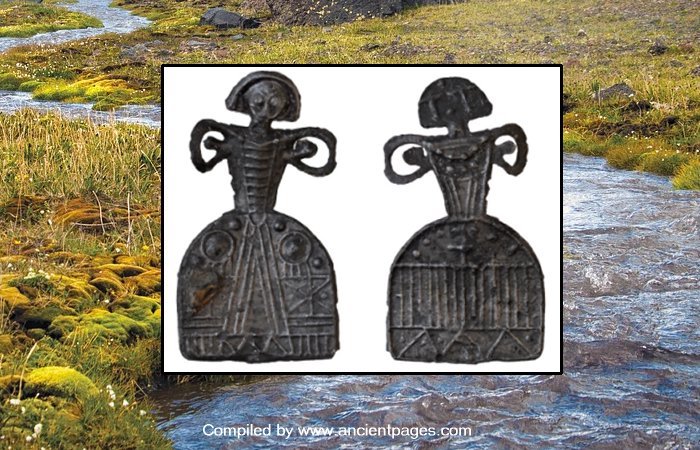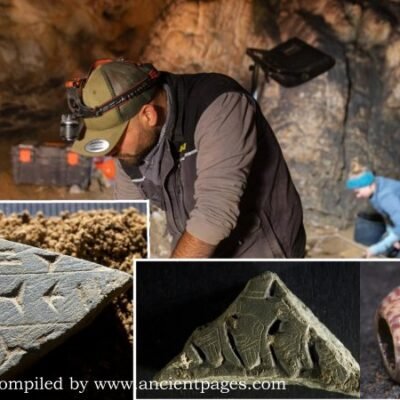Conny Waters – AncientPages.com – The discovery of a rare historical artifact by Sarah Brackstone, a 47-year-old amateur historian and mudlarker from the East Midlands, exemplifies the rewards of persistent searching. Brackstone, who regularly explores streams and rivers with her metal detector, recently uncovered a significant find near her home in Long Whatton, a village between Leicester and Nottingham, UK.
The artifact is a lead doll from the late 16th or early 17th century. This small figure, measuring just over five centimeters, is constructed from thin lead plates and depicts a woman wearing an intricately decorated dress and a cap-like headpiece. Notably, the letters “TT” are inscribed on the back of the doll’s face, potentially representing the signature of its creator.
A complete Post-Medieval lead alloy toy doll, dating to c.AD 1500 – 1650. The doll is a female figure; both sides are decorated, and the front and back decorations are different. According to the British authority PAS, the 17th-century lead doll is the only one to have been found intact. The toy measures just over five cm in height and weighs just over 15 grams. Credit: The British Museum’s Portable Antiquities Scheme
What makes this discovery particularly remarkable is its rarity. According to experts, this post-Medieval lead doll is considered “special” and is believed to be the only complete example recorded in the country. The find has garnered significant interest from historians, highlighting its importance in understanding the period’s toy manufacturing and cultural practices.
Brackstone’s discovery, made using a Minelab Equinox 800 metal detector, underscores the potential for amateur historians and metal detectorists to contribute valuable artifacts to the historical record. This find serves as a tangible link to the past, offering insights into post-Medieval England’s material culture and craftsmanship.
“I was out in the brook and my pinpointer was going off and I could not see anything because the water was all murky,” the 47-year-old who lives in the East Midlands told the PA news agency.
“It must have taken me nearly 20 minutes and I was wrenching her out and didn’t even know what it was.
“When I pulled her out and she was complete, I thought, ‘Oh my God, no way’.”
Sarah Brackstone (right) contacted Megan Gard (left) about the find. Credit: PA
Brackstone reported that she contacted Megan Gard, who serves as the finds liaison officer (FLO) for Leicestershire and Rutland, based at Rutland County Museum. According to Gard, the discovery of the doll created significant excitement among the museum staff. This reaction was due to the rarity of such finds, as the Portable Antiquities Scheme (PAS) database contains records of only a small number of similar doll parts.
Brackstone has found the torso of a similar doll in the past, but finding one complete is “very rare”, according to Michael Lewis, who is head of the Portable Antiquities Scheme (PAS), which records archaeological finds discovered by the public and is run in England by the British Museum.
“It is a fantastic survival.
It’s quite interesting it survives because it’s made from lead, a metal that is quite likely to be broken.
“(It is) probably important to say that the survival of lead objects is more common in watery contexts.
“When these break, the breakage points are unsurprisingly at the head and waist, so we have seen some of these without the head or the dress, so having one that’s completely complete is obviously very rare, ” Professor Lewis told PA.
Brackstone has made numerous discoveries, including human remains, dental artifacts, a Tudor-era spoon, and a 500-year-old beehive thimble. However, her most remarkable find to date is the recently unearthed doll. This discovery is considered exceptionally rare and valuable in the field of archaeology.
The doll shortly after Sarah Brackstone found it and took it home. Credit: Sarah Brackstone/PA
The amateur historian has expressed her enthusiasm for the find, noting its importance in the realm of historical dolls. She has described it as a once-in-a-lifetime discovery, comparing it to finding the “holy grail” of dolls.
See also: More Archaeology News
Regarding the future of this artifact, Brackstone intends to loan the doll to the British Museum for further study and public display. The discovery has also garnered international attention, with collectors from the United States expressing interest in potentially acquiring the item. This level of interest underscores the doll’s historical and monetary value.
Written by Conny Waters – AncientPages.com Staff Writer








